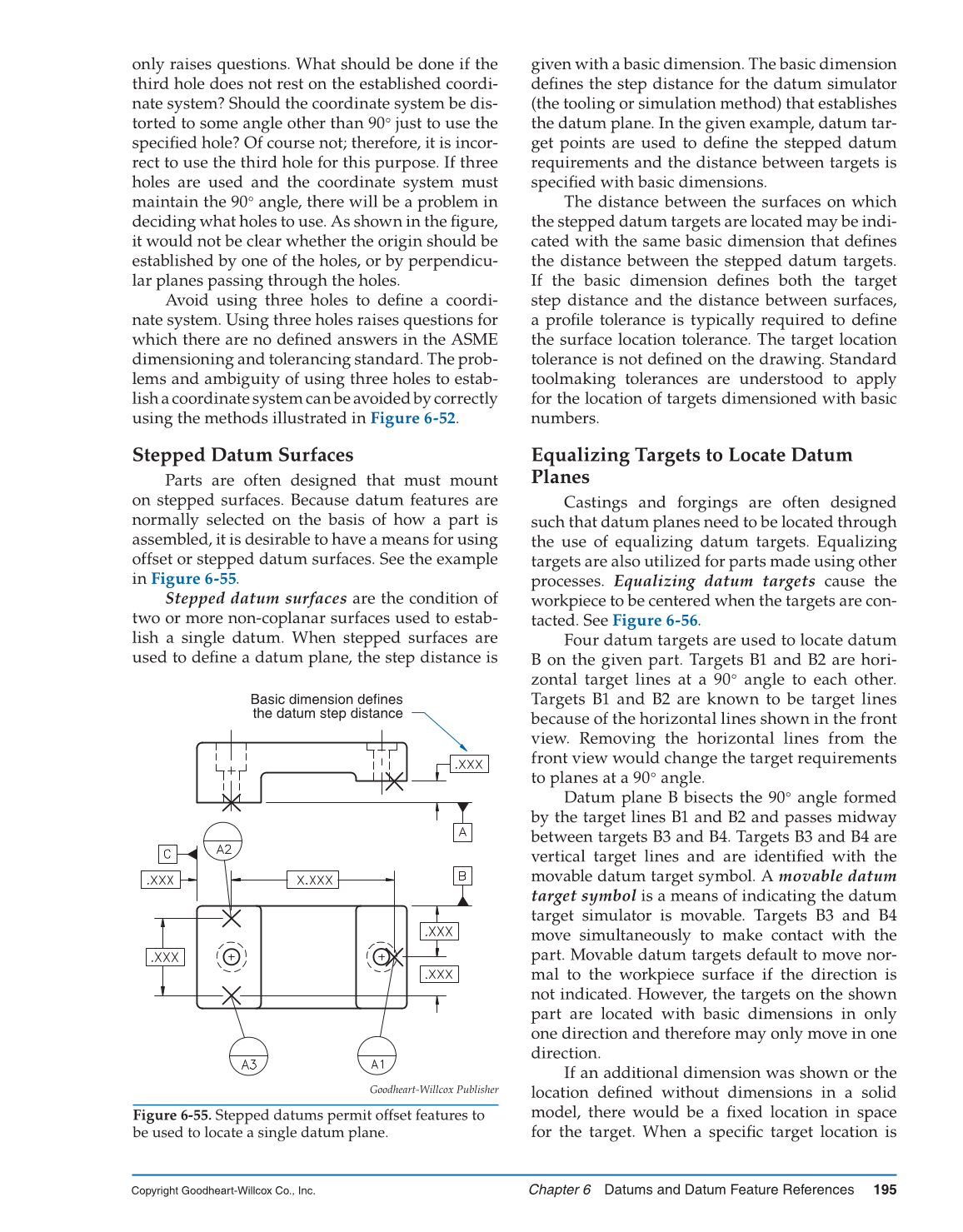Chapter 6 Datums and Datum Feature References 195
Copyright Goodheart-Willcox Co., Inc.
only raises questions. What should be done if the
third hole does not rest on the established coordi-
nate system? Should the coordinate system be dis-
torted to some angle other than 90° just to use the
specifi ed hole? Of course not; therefore, it is incor-
rect to use the third hole for this purpose. If three
holes are used and the coordinate system must
maintain the 90° angle, there will be a problem in
deciding what holes to use. As shown in the fi gure,
it would not be clear whether the origin should be
established by one of the holes, or by perpendicu-
lar planes passing through the holes.
Avoid using three holes to defi ne a coordi-
nate system. Using three holes raises questions for
which there are no defi ned answers in the ASME
dimensioning and tolerancing standard. The prob-
lems and ambiguity of using three holes to estab-
lish a coordinate system can be avoided by correctly
using the methods illustrated in Figure 6-52.
Stepped Datum Surfaces
Parts are often designed that must mount
on stepped surfaces. Because datum features are
normally selected on the basis of how a part is
assembled, it is desirable to have a means for using
offset or stepped datum surfaces. See the example
in Figure 6-55.
Stepped datum surfaces are the condition of
two or more non-coplanar surfaces used to estab-
lish a single datum. When stepped surfaces are
used to defi ne a datum plane, the step distance is
given with a basic dimension. The basic dimension
defi nes the step distance for the datum simulator
(the tooling or simulation method) that establishes
the datum plane. In the given example, datum tar-
get points are used to defi ne the stepped datum
requirements and the distance between targets is
specifi ed with basic dimensions.
The distance between the surfaces on which
the stepped datum targets are located may be indi-
cated with the same basic dimension that defi nes
the distance between the stepped datum targets.
If the basic dimension defi nes both the target
step distance and the distance between surfaces,
a profi le tolerance is typically required to defi ne
the surface location tolerance. The target location
tolerance is not defi ned on the drawing. Standard
toolmaking tolerances are understood to apply
for the location of targets dimensioned with basic
numbers.
Equalizing Targets to Locate Datum
Planes
Castings and forgings are often designed
such that datum planes need to be located through
the use of equalizing datum targets. Equalizing
targets are also utilized for parts made using other
processes. Equalizing datum targets cause the
workpiece to be centered when the targets are con-
tacted. See Figure 6-56.
Four datum targets are used to locate datum
B on the given part. Targets B1 and B2 are hori-
zontal target lines at a 90° angle to each other.
Targets B1 and B2 are known to be target lines
because of the horizontal lines shown in the front
view. Removing the horizontal lines from the
front view would change the target requirements
to planes at a 90° angle.
Datum plane B bisects the 90° angle formed
by the target lines B1 and B2 and passes midway
between targets B3 and B4. Targets B3 and B4 are
vertical target lines and are identifi ed with the
movable datum target symbol. A movable datum
target symbol is a means of indicating the datum
target simulator is movable. Targets B3 and B4
move simultaneously to make contact with the
part. Movable datum targets default to move nor-
mal to the workpiece surface if the direction is
not indicated. However, the targets on the shown
part are located with basic dimensions in only
one direction and therefore may only move in one
direction.
If an additional dimension was shown or the
location defi ned without dimensions in a solid
model, there would be a fi xed location in space
for the target. When a specifi c target location is
Basic dimension defines
the datum step distance
Goodheart-Willcox Publisher
Figure 6-55. Stepped datums permit offset features to
be used to locate a single datum plane.
